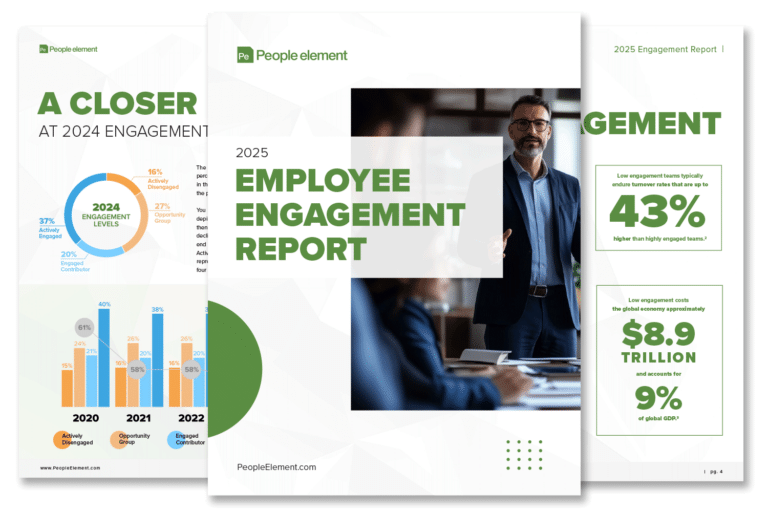Inside the 2025 Employee Engagement Report: Key Trends and Takeaways
Contents
Employee engagement is no longer a “nice to have”—it’s a strategic imperative. Our 2025 Employee Engagement Report reveals a workforce that’s evolving fast: Employees today want more than just a paycheck. They want professional development, leadership transparency, and a meaningful connection to their work.
That emotional connection—how employees feel about their company and their role in it—directly influences motivation, productivity, and retention. In 2024, several major employee engagement trends took center stage: flexible work environments, a renewed focus on inclusivity, and a growing demand for psychological safety.
Organizations that stay attuned to these shifts are seeing the payoff. But those that don’t? They’re grappling with higher turnover and declining performance.
In this breakdown of our annual employee engagement report, we’ll unpack:
- What’s motivating employees today
- Where expectations have shifted
- And how companies can take action using modern employee engagement surveys
Ready to see the full findings? Download the full 2025 Employee Engagement Report below.
The Impact of (Dis)Engagement
One of the clearest takeaways from our 2025 employee engagement report? Engagement isn’t just a feel-good metric—it’s a business driver. Explore the top 10 engagement metrics you should be tracking in this recent blog post.

Organizations with 70% or more of their employees engaged see transformational results: higher profits, stronger productivity, lower turnover, and better well-being across the board.
But here’s the flip side: disengagement is costly. Actively disengaged employees can drag down team morale, increase errors, and quietly chip away at your culture. They’re not just clocking in for a paycheck anymore—if they don’t feel connected, they’ll “work their wage,” quietly quit, or move on entirely.
Low engagement teams typically endure turnover rates that are up to 43% higher than highly engaged teams.
The data shows a striking correlation between engagement and well-being: highly engaged employees experience 81% lower absenteeism and report 66% better overall well-being. Those struggling in their personal or professional lives are nearly twice as likely to leave their job and face significantly higher stress.
When organizations invest in employee engagement surveys and take action on what they learn, they don’t just improve engagement—they support the whole person. And that support pays dividends.
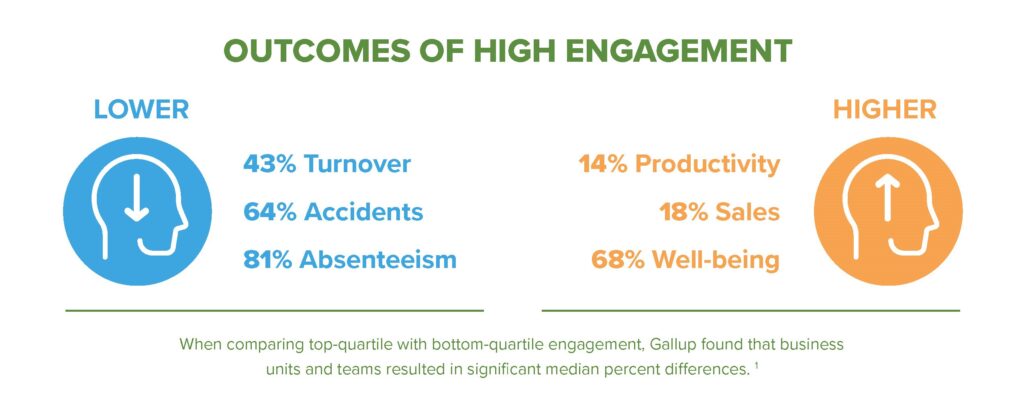
State of Engagement
Measuring engagement is critical in understanding your workforce and its needs. Trends in employee engagement are meaningful since they are linked to many organizational performance outcomes. As you can see from the trend line below, engagement levels have varied over the past five years.
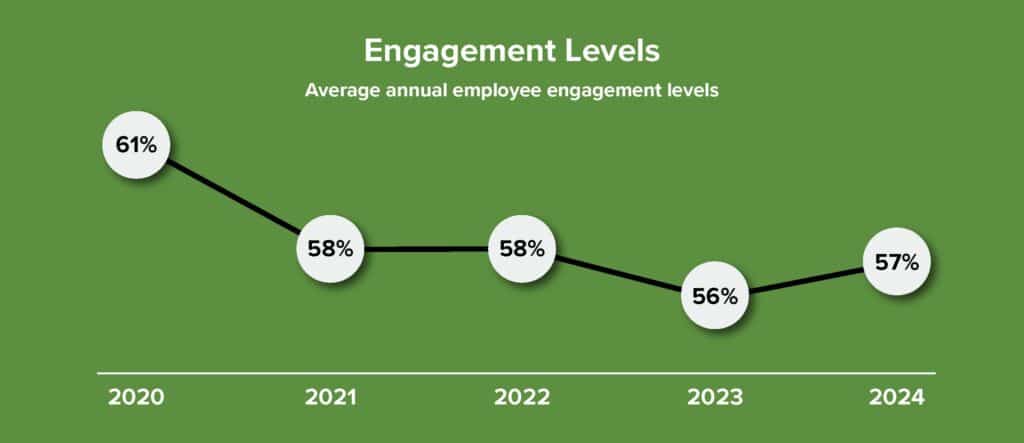
Four Distinct Engagement Groups
When measuring employee engagement, it is not always as simple as separating employees by engaged or disengaged. Instead, engagement can be seen as a spectrum, with the highest levels of engagement on one end and the lowest on the other. People Element separates engagement into four levels:
Actively Engaged – Highly committed to their work, speak highly of the organization, actively growing and learning, and are willing to go above and beyond.
Engaged Contributors – Satisfied with their work, meets expectations, and tends to stay in their comfort zone.
Opportunity Group – Has mixed feelings about work, stays under the radar, and does not actively contribute to the workplace.
Actively Disengaged – Consistently view their work and the company negatively, will speak negatively about the organization and leadership, and likely to quit.
To get a detailed breakdown of each group so you can apply them to your workforce, download our full 2025 Employee Engagement report here.
Employee Engagement Trends in 2024
Our 2025 employee engagement report reveals a steady decline in employee engagement over the past five years.
In 2020, 40% of employees were considered Actively Engaged—the highest level of engagement in our data set. By 2024, that number had slipped to 37%. At the same time, the percentage of Actively Disengaged and Opportunity Group employees has climbed by about four percentage points.
This shift highlights a growing challenge for employers: not only are fewer employees highly engaged, but more are slipping into disengagement.
Tracking this trend with regular employee engagement surveys is key to understanding where your workforce stands—and where there’s room to grow.

Beating the Employee Engagement Trend
Although overall average employee engagement levels have remained flat over the last few years, there are many companies beating the trend and reaching new heights. Our full report highlights four companies that span a range of industries and have reached an engagement score that’s higher than 75% of other companies.
Company 1 – LifeView Group
- Industry: Health Services
- 5+ increase in Employee Net Promoter Score
- 3-point increase in Engagement
- In top quartile for engagement level
- 80%+ Favorability maintained
- Read the case study
Company 3
- Industry: Government
- 80%+ Participation
- 6% increase in Favorability
- 13% increase in Engagement
- Read the case study
Company 2 – Nussbaum
- Industry: Transportation
- 10-point increase in Engagement
- 80%+ Engagement, top quartile
- 5-point increase in Favorability
- 88%+ Favorability
- Read the case study
Company 4 – Prosser Memorial
- Industry: Healthcare
- 12-point increase in Engagement
- 85%+ Engagement level, top quartile
- 10-point increase in Favorability
- 90%+ Favorability, top quartile
- Read the case study
So what made the difference for them?
- Consistency – Long-term commitment to employee engagement and they administered surveys consistently on a set cadence.
- Transparency – Results and data are shared with leadership, managers, and front-line employees.
- Action Planning – Action is taken at the org-wide level and across key groups (department, manager, etc.)
Key Drivers Behind Employee Engagement in 2025
Key Drivers indicate what questions or categories have the greatest impact on employee engagement levels.
One of the strongest ways to improve employee engagement is simple: ask for feedback—and act on it.
Our 2024 employee engagement survey data reveals the top drivers linked to high engagement across hundreds of organizations. These insights help leaders focus on what actually moves the needle.
- OPPORTUNITIES FOR GROWTH
- FEELING VALUED
- TRUST & CONFIDENCE IN LEADERSHIP

Opportunities for Growth
Employees want to grow—and when they don’t see a clear path, they disengage. In fact, 63% of employees cite lack of career advancement as a reason for leaving a job.
But here’s the challenge: only 1 in 4 employees feels confident in their career trajectory, and just 1 in 3 knows how to progress. Without visible support and guidance, even high performers are likely to look elsewhere.
To keep talent engaged, organizations need to invest in skill-building, mentorship, and transparent development plans. Growth conversations should be personal, ongoing, and tied to both individual and business goals.
1 in 3 employees do not feel they are provided with opportunities to grow professionally
46% do not feel they can be promoted
62% feel there is a fair process for considering employees for job openings
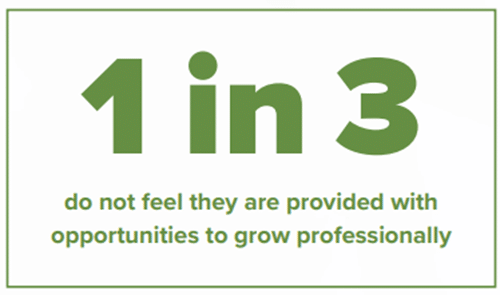
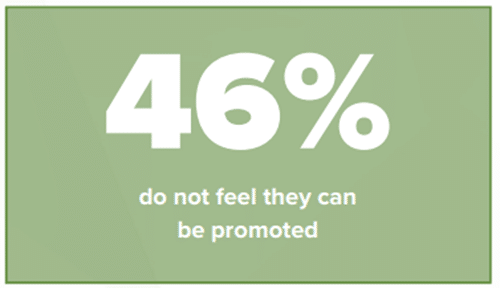
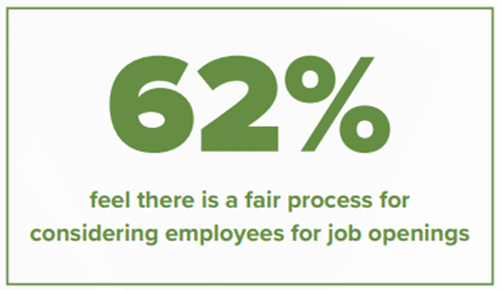
With AI and automation reshaping the workforce, now is the time to reskill and realign. The future belongs to companies that treat internal mobility and employee development as strategic priorities.
Actionable methods of enhancing employee growth:
- Create personalized development plans – tailor career paths based on individual strengths, goals, and learning preferences to foster continuous skill-building and engagement.
- Offer continuous learning & upskilling – offer ongoing training, mentorship, and access to educational resources to help employees adapt to evolving industry demands.
- Pave clear career progression pathways – define transparent promotion criteria and career ladders to motivate employees and provide a sense of direction.
- See the rest in the full report!
Feeling Valued
Feeling valued is now one of the most important drivers of employee engagement, even outranking compensation. Nearly one-third of employees in our 2024 survey said they don’t feel valued at work.
37% of employees feel that leadership’s actions do not show they value employees
63% feel that leadership’s actions show they value employees

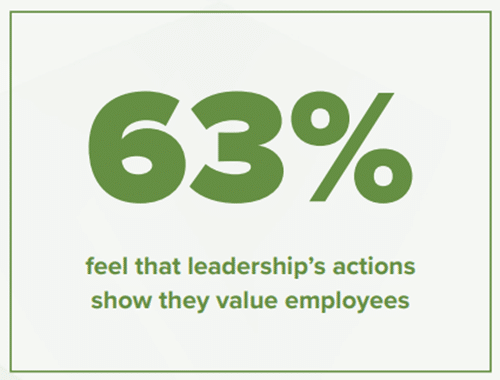
Today’s workforce—especially Gen Z—isn’t just working for a paycheck. They’re looking for meaning, recognition, and day-to-day support. In fact, research shows less than half of Gen Z feel their manager helps maintain a manageable workload, and over a quarter say that lack of support affects their mental health.
Organizations that actively recognize contributions and foster inclusion see stronger employee engagement and improved retention across teams.
Actionable ways to make employees feel heard and valued:
- Prioritize transparency and authentic communication – employees want leaders who connect with them in real, honest ways.
- Act on employee feedback – show that employee opinions matter by acting on their input.
- Implement frequent check-ins – between employees and managers to address concerns and gather immediate feedback.
- See the rest in the full report!
Trust & Confidence in Leadership
Trust in leadership is a major driver of employee engagement— and right now, that trust is slipping.
Our 2025 data shows a consistent lack of confidence in senior leaders. Only 32% of employees trust their leaders to make the right decisions, and just 29% trust their managers—a sharp drop from recent years. Gallup reports an even lower figure: just 20% of U.S. employees strongly trust their leadership.
37% feel there’s not sufficient communication from senior leadership
65% say leadership communicates a clear vision for the future
2 in 3 employees do not feel informed about matters that affect them

Factors like burnout, mental health challenges, and workplace surveillance have widened this trust gap. And despite growing concerns, many leaders haven’t taken steps to rebuild that trust.
Clear, consistent communication is one of the most effective tools for doing so. Especially during times of uncertainty—economic shifts, AI disruption—leaders who communicate early and often are more likely to keep employees aligned, confident, and engaged.
Actionable strategies to enhance trust & confidence in leadership:
- Communicate the company’s vision – continuously reinforce the company’s mission, values, and long-term goals to help employees see the bigger picture and align their work with purpose.
- Act on feedback – demonstrate that employee input is valued by taking meaningful actions based on their suggestions and concerns.
- Lead by example – model the behavior you expect from others by being honest, approachable, and responsive in your communication.
- See the rest in the full report!

Trends in the Workplace
Understanding workplace trends isn’t just about staying informed—it’s about staying competitive. As the needs and expectations of employees shift, trends like economic uncertainty, hybrid work preferences, and the rapid adoption of AI are redefining how people engage at work. Organizations that pay attention to these changes are better positioned to boost engagement, build trust, and retain top talent. In this overview, we explore the key trends shaping 2025 and how they’re influencing the employee experience.
Economic Uncertainty
In 2024, economic volatility hit the workplace hard. Inflation, interest rate hikes, and layoffs created a climate of uncertainty that left many employees concerned about job security and financial stability.
In this environment, employees looked to leadership for reassurance. And what made the biggest difference? Transparent communication. Companies that kept their people informed—about finances, direction, and long-term plans—were better equipped to maintain employee engagement through the turbulence.
That need hasn’t gone away. In 2025, continued inflation and slower GDP growth are keeping uncertainty high. To keep engaged employees, organizations must double down on clear messaging around compensation, benefits, and organizational health.
Without that transparency, employee trust declines—and employee engagement tends to follow.
Preference for Hybrid Work Model
Since 2020, remote work has evolved into a mix of in-office, hybrid, and fully remote models. As of mid-2024, 60% of North American companies had adopted a hybrid approach.
Employees have made their preferences clear: flexibility matters. Nearly two-thirds of fully remote workers, and 29% of hybrid workers, say they’d likely look for a new job if remote options were removed.
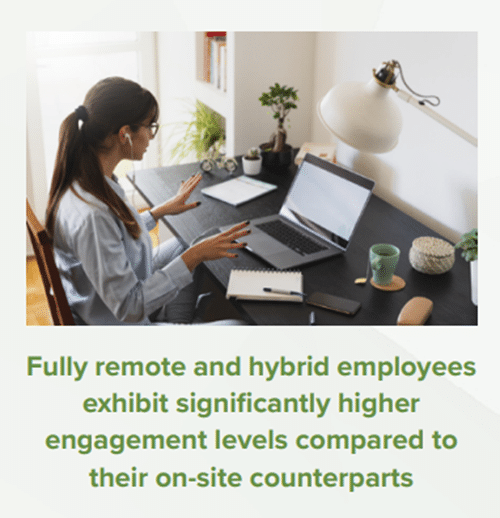
Hybrid work doesn’t just meet employee preferences—it improves retention and productivity. A study by a Stanford economist found that hybrid employees were just as productive and promotable as their in-office peers, and resignations dropped by 33% after shifting to a hybrid model. Other data shows that remote and hybrid workers report higher employee engagement than fully on-site teams.
Fully remote and hybrid employees exhibit significantly higher engagement levels compared to their on-site counterparts.
To maintain that engagement, organizations must be intentional about how they structure and manage hybrid policies—balancing flexibility with clarity.
AI in the Workplace
AI is officially here—and growing fast. As of 2024, 75% of employees are using AI at work, with nearly half adopting it in just the past six months.


But while adoption is high, feelings are mixed. Around 85% of employees believe AI will impact their job in the next few years, and many—especially remote and younger workers—fear it may replace them. This has led to a rise in “AI anxiety,” with 71% of workers expressing concern.
Despite these fears, AI skills are in demand. Over 70% of leaders say they’d hire a less experienced candidate with AI expertise over a more seasoned one without. Yet most employees using AI (61%) say they aren’t getting proper training from their company.
To address these concerns and mitigate “AI anxiety”, organizational leaders can:
- Provide clear communication
- Invest in training
- Foster collaborative environments
Learn how in the full 2025 Employee Engagement Report.
Prioritizing Employee Engagement for Long-Term Success
Every company wants higher employee engagement, but when priorities pile up, it can fall by the wayside. The truth? Organizations that prioritize engagement see real, measurable results—better well-being, productivity, retention, and more.
When you actively listen to employees and take focused action, you create a culture where people are happy, committed, and invested in their work.
Engaged employees don’t just perform better—they help your entire organization thrive. Maybe it’s time engagement moved to the top of the priority list.
Here are actionable steps to nurturing your employee engagement moving forward:
- Make engagement a priority – The benefits of increasing engagement are undeniable. However, these benefits do not come easy. The organization must commit to focusing on engagement and dedicating the time and resources necessary to reap the rewards.
- Get employee feedback – You cannot guess what drives employee engagement. Employee feedback is invaluable and collecting this feedback is an essential part of the process.

- Create a plan of action – Be ready to act on your data by planning ahead. How will you take action? Who will be responsible for taking action? How will they be held accountable? Creating a plan of action in advance ensures you will not stall when the time comes, and you will not let your employees down by not following through.
- Communicate – A major key to success is communicating with your employees. As a best practice you should create a detailed communication plan that aims to keep employees updated every step of the way.
- Be consistent – When you choose to make employee engagement a priority, you are committing to a continuous journey. You should obtain employee feedback on a set cadence. Employee perceptions can shift quickly, and it is important to stay vigilant.

Employee Engagement Surveys With People Element

We believe every employee should have a voice. We believe every organization can be better tomorrow by acting on employee insights today. We hope this report helps you achieve the change your company needs to improve the employee experience and, as a result, take advantage of the benefits a highly engaged workforce can provide.
People Element helps organizations achieve meaningful change through powerful employee surveys. Our easy-touse platform and streamlined process provide best-in-class service tailored to your unique needs. With a science-backed solution built on 35+ years of experience in I/O Psychology and an all-inclusive pricing model, we empower you to gather insights and take action with confidence.
Download the full 2025 Employee Engagement Report here.
Ready to streamline your engagement surveys and get actionable insights? Watch a product tour of our employee engagement survey platform today.

